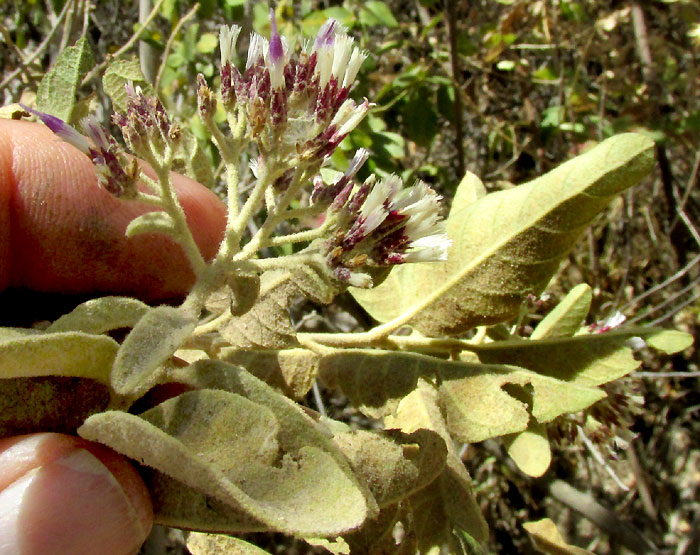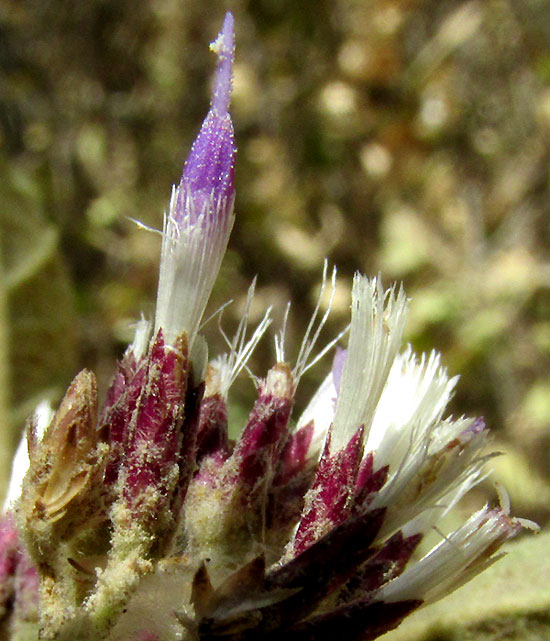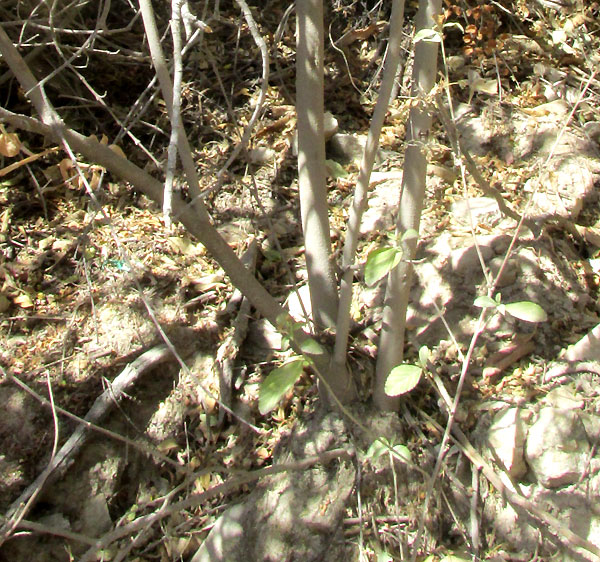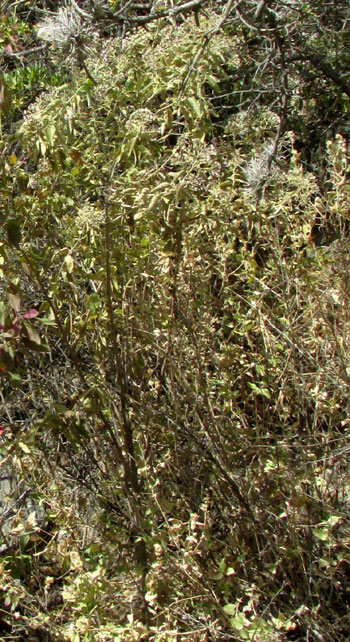Excerpts from Jim Conrad's
Naturalist Newsletter
entry from field notes dated January 17, 2023, taken on trail up the southeast-facing slope of Peña de Bernal on the northwestern side of Bernal, elevation ±2,220m (7280 ft); bedrock of intrusive, igneous dacite rock, similar to granite; Querétaro state, MÉXICO, (N20.748°, W99.949°)
EREMOSIS TOMENTOSA

The dry season being exceptionally rainless, with the previous rainy season never quite developing, vegetation along the steep trail up Peña de Bernal's scrubby slope was crispy dry, and most leaves still hanging on trees and bushes tended to be limp and fading. Still, a certain small tree firmly enmeshed in the slope's brushy vegetation bore what's shown above. Clearly this is a member of the vast Composite or Aster Family, the Asteraceae, but it's an unusual one. Not only is the species woody, in a family predominantly herbaceous, but also its leaves are extremely woolly. Also, exceptionally long, white bristles -- the pappi -- emerge from the heads' involucres, plus something notable is going on with the flowering head at the picture's far left, shown closer up below:

It looks like a single, oversized disc floret has risen from its scaly involucre, with correspondingly remarkably long pappus bristles wrapped around its base. Emerging from the purple disc floret corolla is a fingerlike item consisting of two closed-up style-branches, with white pollen grains adhering to the branches' fuzzy surfaces.

Above we see the character of the hairiness on the lower surface of a leaf. And here's the tree's base wedged among the steep slope's outcropping rocks:


At the right our tree is hardly visible amid other surrounding trees, bushes and vines.
In the treatment of this species in the 1995 Flora del Bajío, which covers our area, this tree fairly easily reveals itself-- with its woody nature, single floret per flowering head, and dense hairiness covering its simple, undivided leaves -- as Vernonia paniculata. In North America, the genus Vernonia is well known, its several species often known as "ironweeds," their big inflorescences of purple flowers a conspicuous feature in the late-summer and fall landscape, especially in the East. However, while the genus Vernonia survives, the name Vernonia paniculata no longer is recognized. Most experts now refer to our plant as EREMOSIS TOMENTOSA, this species and certain others having been banished from Vernonia. One feature distinguishing them from ironweeds is the presence of a single or very few florets present in each flowering head.
The genus Eremosis is endemic just to Mexico and parts of Central America. Our Eremosis tomentosa is endemic just to central and west-central Mexico. Within this limited area of distribution, it's regarded as fairly common, often turning up in tropical deciduous forests, especially disturbed ones. Our plant enmeshed in its thicket of scrub seems to occupy its typical environment.
The literature doesn't tell us much about Eremosis tomentosa, though a 2003 publication by María Campos and others, entitled "Relaxation of Uterine and Aortic Smooth Muscle by Glaucolides D and E from Vernonia liatroides," tells us that various Vernonia species are used in Latin America for menstrual and stomach disorders. Thinking that such a use may imply "smooth muscle relaxing properties" exhibited by compounds in the genus -- and at the study's publication date our plant was considered a Vernonia -- our Eremosis tomentosa was analyzed and found to contain the hirsutinolide [1R,4S,5R,6S,8S,10R]-8,10,13-triacetoxy-1(4)-epoxy-1,5-dihydroxygermacr-7(11)-en-6(12)-olide, which I think they found made sense for a plant that might relax smooth muscles.